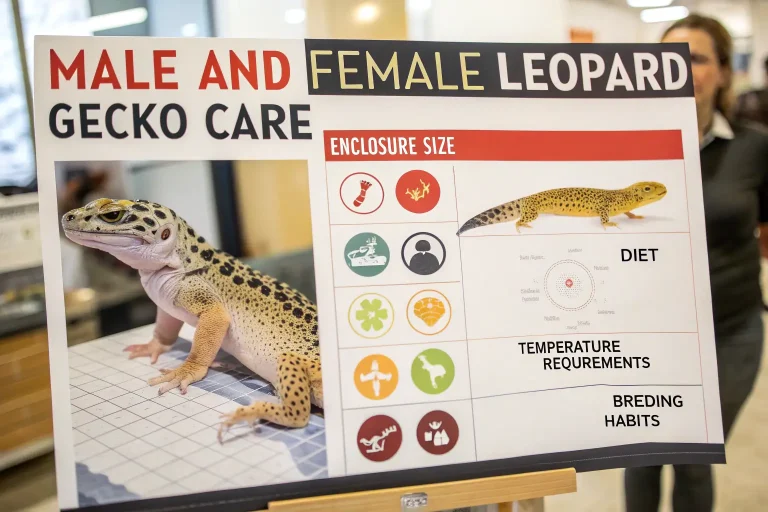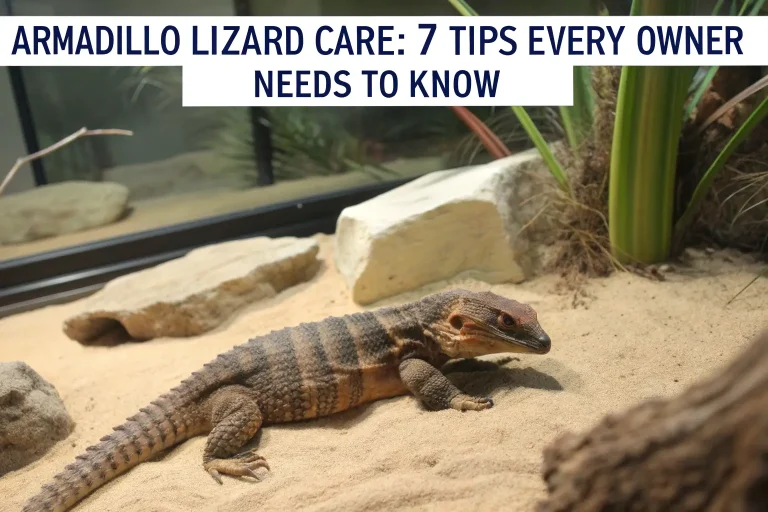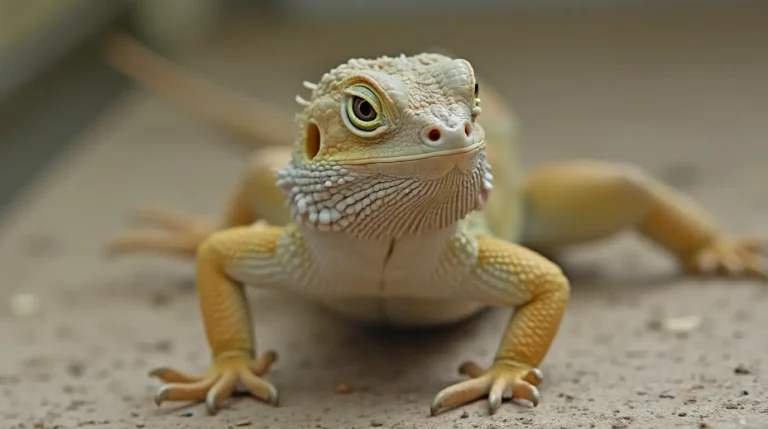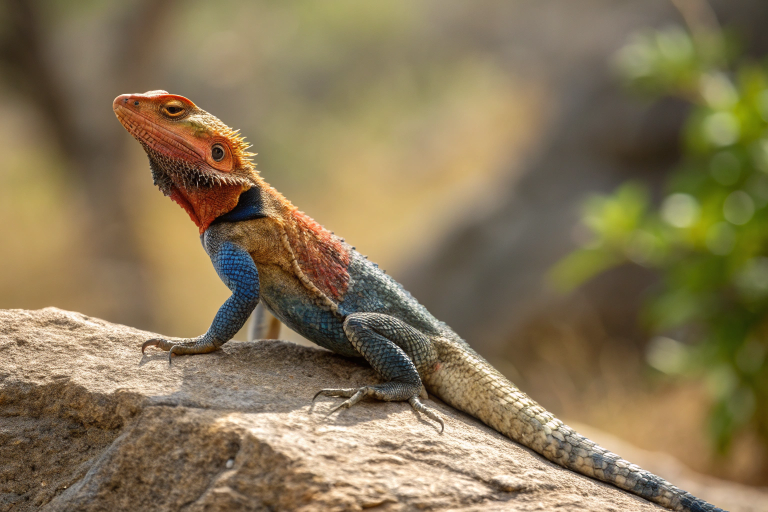Western Fence Lizard 101: 7 Surprising Facts You Need to Know
Ever wondered what secrets the western fence lizard holds? Dive into our blog post to uncover 7 fascinating facts about this reptile. Get tips on lizard care and more. Discover now!
Introduction
Have you ever been hiking on a warm day and noticed a small blue-bellied lizard scurrying across your path or doing push-ups on a rock? Chances are, you’ve encountered the western fence lizard, one of North America’s most common and charismatic reptiles.
The western fence lizard might seem like just another ordinary backyard critter, but this remarkable reptile has several surprising qualities that make it worthy of our attention. From disease-fighting blood to impressive athletic abilities, these small lizards play a significant role in their ecosystems and have even contributed to human health research.
Did you know that these little creatures might actually be protecting you from Lyme disease? That’s just one of the fascinating aspects we’ll explore as we dive into the world of the western fence lizard, a small reptile with big ecological importance.
[IMAGE SUGGESTION: Close-up of a western fence lizard displaying its vibrant blue belly while basking on a rock]
Species Overview
Scientific Classification
The western fence lizard (Sceloporus occidentalis) belongs to the family Phrynosomatidae, which includes spiny lizards and horned lizards. This species is commonly known as the “blue-belly” due to the vivid blue patches on the male’s underside.
Physical Characteristics
These small, agile reptiles typically reach 5.7-8.9 inches (14.5-22.5 cm) in total length, with males generally larger than females. The western fence lizard sports a robust build with:
- Coloration: Varying shades of brown, gray, or black on the back and sides
- Pattern: Dark crossbands or wavy markings across the back
- Distinctive feature: Males display bright blue patches on their belly and throat, which become more vibrant during breeding season
- Scales: Keeled, giving them a somewhat rough texture
Their physical attributes make them well-adapted for climbing walls, fences, and trees—hence their common name.
Subspecies
Researchers recognize several subspecies of western fence lizards based on geographic location and slight variations in appearance:
- S. o. occidentalis: The Pacific western fence lizard
- S. o. biseriatus: The Great Basin western fence lizard
- S. o. longipes: The Great Basin fence lizard
- S. o. bocourtii: The Coast Range fence lizard
Each subspecies has adapted to its specific regional habitat conditions, showing the remarkable diversity within this single species.
[IMAGE SUGGESTION: Side-by-side comparison of different western fence lizard subspecies showing slight color and pattern variations]
Habitat and Distribution
Natural Habitat
The western fence lizard thrives in diverse environments, showing remarkable adaptability. You’ll find them in:
- Grasslands and meadows
- Woodland edges and clearings
- Chaparral and scrubland
- Suburban environments (yards, parks, gardens)
- Rocky areas where they can bask and seek shelter
They particularly favor areas with vertical structures for basking and displaying. Whether it’s rocks, fallen logs, fence posts (true to their name!), or even your garden wall, these lizards make excellent use of these surfaces for thermoregulation and territorial displays.
Geographic Range
These versatile reptiles occupy a significant portion of western North America, primarily distributed throughout:
- Most of California
- Western Nevada
- Oregon
- Washington
- Parts of Idaho
- Northern Baja California (Mexico)
- Western Utah
Their elevation range is equally impressive, occurring from sea level to elevations of up to 10,800 feet (3,300 meters) in the Sierra Nevada mountains. [Learn more about reptile distribution patterns here]
Adaptations
Western fence lizards have evolved several key adaptations that enable their success across varied environments:
- Thermal regulation: Their ability to precisely manage body temperature through basking behavior
- Color matching: Their dorsal coloration often blends with local rock and soil types
- Speed and agility: Quick reflexes and sprinting ability to evade predators
- Climbing ability: Specialized toe pads and claws for navigating vertical surfaces
- Water conservation: Efficient kidneys and specialized scales that reduce water loss
Perhaps most fascinating is their behavioral adaptation of doing “push-ups” – rapid up and down movements that serve as territorial displays and help them assess temperature gradients across surfaces.
Diet and Feeding Habits
What It Eats
The western fence lizard is primarily insectivorous, feasting on a variety of small invertebrates. Their diet typically includes:
- Small beetles and their larvae
- Various ants and other small hymenopterans
- Grasshoppers and crickets
- Spiders (including small scorpions)
- Flies and mosquitoes
- Caterpillars and other soft-bodied insects
- Occasionally small snails
This varied diet not only sustains the lizards but also makes them valuable natural pest controllers in gardens and yards. They’re particularly effective at reducing populations of many nuisance insects.
Hunting or Foraging Behavior
These lizards employ a sit-and-wait hunting strategy, often described as “ambush predation.” Their typical hunting pattern follows this sequence:
- Positioning: Finding an elevated perch with good visibility
- Vigilance: Remaining motionless while scanning surroundings
- Pursuit: Rapid bursts of speed to capture detected prey
- Consumption: Quick head movements to seize and crush prey
Unlike some reptiles that are active foragers, western fence lizards conserve energy by waiting for prey to come within striking distance, then using explosive speed for the actual capture.
Dietary Needs
In the wild, these lizards obtain most of their hydration from the food they eat rather than drinking water directly. Their nutritional requirements include:
- Protein: Essential for growth and tissue repair
- Calcium: Critical for bone development and egg production
- Vitamins: Obtained through varied prey items
Seasonal variations occur in their diet, with increased feeding during spring and summer to build fat reserves for winter brumation (a hibernation-like state). Juvenile lizards tend to focus on smaller prey items while growing rapidly during their first year.
[IMAGE SUGGESTION: Western fence lizard in action capturing an insect prey with its quick movements]
Behavior and Social Structure
Social Behavior
The western fence lizard exhibits fascinating social dynamics centered around territorial defense. Males are notably territorial, establishing and defending areas that may contain multiple females. Key social behaviors include:
- Dominance displays: Males perform push-ups while showing off their bright blue undersides
- Territorial patrolling: Regular movements along territory boundaries
- Basking groups: Despite territoriality, they often bask in loose aggregations when space is limited
- Hierarchical structure: Dominant males secure the best basking sites and access to females
While not truly social in the way mammals might be, these lizards demonstrate complex interaction patterns that balance competition with coexistence.
Communication
Western fence lizards communicate primarily through visual signals rather than vocalizations:
- Push-up displays: Rapid up-and-down movements that signal territory ownership and strength
- Color flashing: Deliberate exposure of blue belly patches during confrontations
- Head-bobbing: Quick nods that function as recognition signals
- Body posture: Flattening or raising the body to appear larger during conflicts
- Chemical cues: Scent marking through specialized femoral pores on their thighs
These communication methods are particularly important during breeding season when competition for mates intensifies.
Mating and Reproduction
The reproductive cycle of western fence lizards follows seasonal patterns:
- Breeding season: Typically April through June
- Courtship: Males perform elaborate push-up displays and approach females with distinctive side-stepping movements
- Clutch size: Females lay 3-17 eggs (averaging 6-8)
- Multiple clutches: Can produce 2-3 clutches per season in favorable conditions
- Incubation: Eggs hatch after 7-9 weeks in soil temperatures of 75-85°F (24-29°C)
- Maturation: Juveniles reach sexual maturity at 1-2 years of age
- Lifespan: Average 5-7 years in the wild, potentially longer in captivity
Unlike some reptiles, western fence lizards show no parental care after egg-laying. The young are fully independent from hatching and must immediately fend for themselves.
Conservation Status
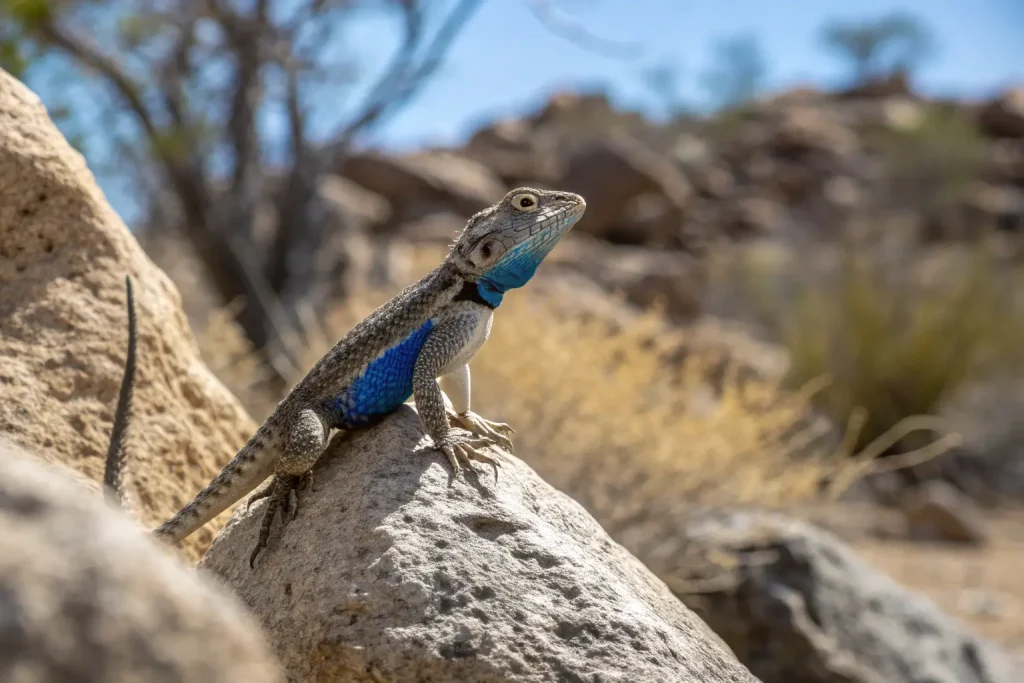
Endangerment Level
Currently, the western fence lizard holds a conservation status of Least Concern on the IUCN Red List. Their abundant populations and adaptability to various habitats have helped maintain stable numbers across most of their range. However, localized declines have been observed in heavily urbanized areas.
Threats
Despite their overall stable status, western fence lizards face several challenges:
- Habitat fragmentation due to urban development
- Predation by domestic and feral cats
- Pesticide exposure in agricultural and suburban settings
- Road mortality as they cross paved surfaces
- Climate change impacts, particularly in lower elevation habitats
- Competition from introduced species in some regions
- Collection for the pet trade (though less common than for other reptile species)
While not endangered, monitoring these threats remains important for ensuring their continued presence in western North American ecosystems.
Conservation Efforts
Several approaches help protect western fence lizard populations:
- Habitat preservation through local conservation areas and parks
- Research programs monitoring population trends and health
- Public education about their ecological benefits
- Lyme disease research highlighting their importance to human health
- Backyard habitat initiatives encouraging homeowner practices that support native wildlife
- Reduced pesticide use in areas where they serve as natural pest control
Conservation organizations recognize that while not glamorous or endangered, these common lizards serve as important indicators of ecosystem health and deserve protection. [Learn more about supporting reptile conservation here]
Interesting Facts
7 Surprising Western Fence Lizard Facts
1. They’re Natural Lyme Disease Fighters
Perhaps most remarkably, the western fence lizard’s blood contains a protein that kills the bacterium responsible for Lyme disease. When infected ticks feed on these lizards, the bacteria in the tick’s gut are neutralized, effectively cleansing the tick. This makes these lizards important for reducing Lyme disease rates in their range!
2. They’re Champion “Push-up” Athletes
Males can perform rapid push-ups for extended periods, sometimes completing dozens in succession. This behavior helps them assert dominance, attract mates, and regulate their body temperature.
3. The Blue Belly Has a Purpose
The vivid blue coloration on males’ undersides isn’t just for show—it contains reflective properties in the ultraviolet spectrum that other lizards can see but is less visible to predatory birds, serving as a secret communication channel.
4. They’re Excellent Climbers
Their specialized toe structures allow them to climb vertical surfaces with remarkable agility, including smooth concrete walls and wooden fences. They can even hang upside-down momentarily!
5. They Have “Third Eye” Capabilities
Like many lizards, western fence lizards possess a parietal eye—a light-sensitive organ on top of their head that can’t form images but detects light changes and helps regulate circadian rhythms and hormone production.
6. They’re Temperature Masters
These lizards can regulate their body temperature with remarkable precision, maintaining optimal internal temperatures by adjusting their position relative to the sun within just a few degrees of their target temperature.
7. They’re Important Mesopredators
While they eat insects, western fence lizards themselves serve as crucial food sources for larger predators like snakes, hawks, and roadrunners, making them an essential link in western North American food webs.
[IMAGE SUGGESTION: Infographic showing all seven interesting facts with small illustrations for each]
Tips for Caring for the Western Fence Lizard
While it’s generally best to let these beneficial reptiles remain wild, they are occasionally kept as pets where legal. If you’re considering keeping one (check local regulations first!) or want to make your yard more lizard-friendly, here’s what you need to know:
Habitat Requirements
Creating an appropriate enclosure includes:
- Terrarium size: Minimum 20-gallon tank for a single adult
- Temperature gradient: 75-85°F (24-29°C) cool side to 90-95°F (32-35°C) basking spot
- UVB lighting: Essential for vitamin D3 synthesis and calcium metabolism
- Climbing structures: Branches, rocks, cork bark for vertical space
- Substrate options: Sand/soil mix or reptile carpet
- Hide spots: Multiple shelters on both warm and cool sides
- Shallow water dish: For drinking and humidity
Feeding in Captivity
A proper diet includes:
- Primary food: Crickets, mealworms, and other small insects
- Variety: Occasional waxworms, small roaches, and other invertebrates
- Frequency: 5-7 small insects daily for adults, more for juveniles
- Supplements: Calcium powder (with D3) dusted on food 2-3 times weekly
- Vitamin powder: Once weekly dusting
Health Considerations
Watch for these common health indicators:
- Normal behavior: Active during daylight, alert, good appetite
- Warning signs: Lethargy, weight loss, difficulty shedding, closed eyes
- Common issues: Metabolic bone disease, respiratory infections, parasites
- Veterinary care: Find an exotic pet veterinarian with reptile experience
- Hibernation needs: May brumate in winter months with reduced activity
Important note: Wild-caught specimens often carry parasites and may not adjust well to captivity. If you’re interested in keeping lizards, consider captive-bred species specifically adapted to terrarium life rather than removing wild animals from their habitat. [Learn about responsible reptile keeping here]
Role in the Ecosystem
Ecological Importance
The western fence lizard functions as both predator and prey, creating a vital link in western North American ecosystems:
- Insect population control: Each lizard consumes thousands of insects annually
- Disease mitigation: Their blood proteins reduce Lyme disease prevalence by cleansing infected ticks
- Food source: They provide critical nutrition for many predator species
- Energy transfer: They convert insect biomass into more concentrated energy for larger animals
- Biodiversity support: Their presence indicates healthy ecosystems that can support diverse wildlife
Scientists consider them “keystone species” in some environments, where their presence has disproportionately large effects on community structure.
Impact of Decline
If western fence lizard populations were to significantly decline, several ecological consequences might follow:
- Increased insect populations, potentially leading to plant damage and crop losses
- Higher Lyme disease rates in regions where they currently suppress the bacteria
- Decreased predator populations that rely on them for food
- Altered food web dynamics affecting multiple trophic levels
- Reduced biodiversity through cascading effects on dependent species
Their common presence makes it easy to overlook their importance, but these lizards represent a crucial thread in the ecological tapestry of western North America.
[IMAGE SUGGESTION: Visual diagram showing the western fence lizard’s position in the food web, with arrows connecting to their prey items and predators]
Conclusion
The western fence lizard proves that extraordinary qualities often come in seemingly ordinary packages. From their disease-fighting blood to their impressive climbing abilities and ecological significance, these common reptiles deserve our attention and appreciation.
Next time you spot one of these blue-bellied creatures doing push-ups on a fence post or scurrying across your garden path, take a moment to appreciate the remarkable adaptations and ecological roles packed into such a small package. Though they may seem commonplace, western fence lizards represent an important natural resource that contributes to healthier ecosystems and even human wellbeing.
Whether you’re a wildlife enthusiast, homeowner, or simply curious about the natural world, understanding and protecting these fascinating lizards benefits us all. Consider creating lizard-friendly spaces in your yard by reducing pesticide use, providing rock piles for basking, and maintaining native vegetation. Small actions can make a big difference in supporting these beneficial reptiles.
What role do the common wildlife species in your area play in the local ecosystem? Sometimes the most important ecological players are the ones we barely notice.
Frequently Asked Questions
Are western fence lizards dangerous to humans or pets?
No, western fence lizards are completely harmless to humans and pets. They cannot deliver venomous bites, don’t carry diseases transmissible to humans, and typically flee rather than confront larger animals. In fact, their presence is beneficial as they help control insect populations and reduce Lyme disease prevalence.
How can I attract western fence lizards to my yard?
Create lizard-friendly habitat by:
- Providing rock piles, logs, or wooden fences for basking
- Maintaining some open, sunny areas
- Planting native vegetation that attracts insects
- Avoiding pesticide use
- Installing shallow water features
- Leaving leaf litter in some areas for foraging and shelter
- Creating rock crevices or brush piles for hibernation sites
Why do western fence lizards do push-ups?
The distinctive push-up behavior serves multiple purposes:
- Territorial display to other males
- Courtship display to attract females
- Species recognition to identify themselves to other fence lizards
- Thermoregulation by adjusting their height above hot surfaces
- Predator assessment to better see potential threats
Is it legal to keep western fence lizards as pets?
Laws vary by location. In many states within their natural range, collection restrictions exist or permits may be required. Always check local wildlife regulations before considering keeping any wild animal. Even where legal, wild-caught specimens often struggle to adapt to captivity and may carry parasites. If you’re interested in keeping lizards, captive-bred species from reputable breeders are generally a more ethical and successful option.
How do I tell male and female western fence lizards apart?
Males have:
- Bright blue patches on their belly and throat
- Larger head and body size
- More pronounced femoral pores (small dots) along their thighs
- More robust build overall
Females have:
- Little to no blue coloration (sometimes faint blue)
- Smaller head relative to body
- Less prominent femoral pores
- Often display mottled patterns on their back
What should I do if I find a western fence lizard in my house?
Simply capture it gently using a small container and release it outdoors near rocks, plants, or other cover. They enter homes accidentally and will thrive better in their natural environment. To prevent future visits, check for small entry points around doors, windows, and foundations.
Do western fence lizards hibernate?
Rather than true hibernation, they undergo brumation—a period of reduced activity during cold months. In winter, they seek sheltered locations like rock crevices, burrows, or thick vegetation where they remain largely inactive until temperatures warm in spring. This state allows them to survive with minimal food intake during unfavorable conditions.


